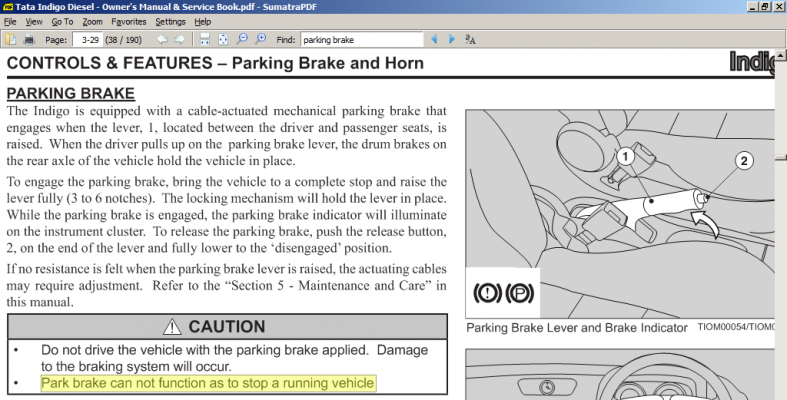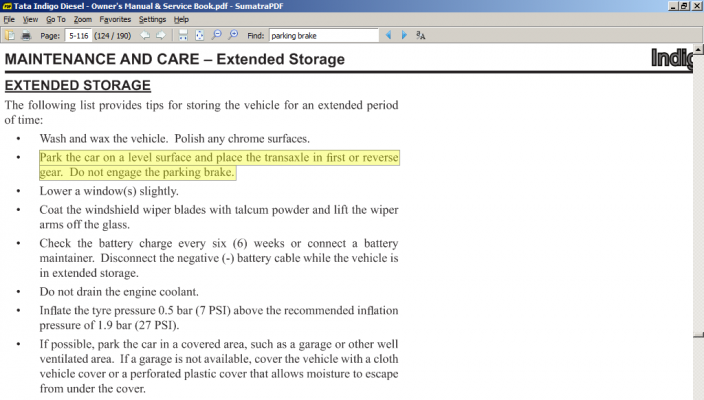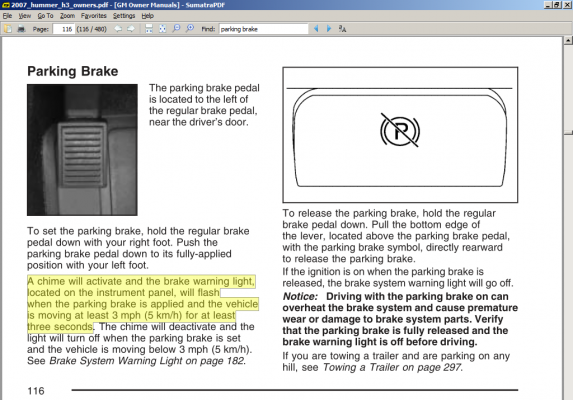When you brake at normal signal - D + Brake. When you brake for a longer period of time (say 3 mins+ but you want to keep the car running, and you are on the road, e.g. Jam), N + Handbrake, when you have actually parked the car P + Handbrake.
Car & Bike Automatic Transmission - should we shift to Neutral at a standstill ?
- Thread starter raksrules
- Start date
You are using an out of date browser. It may not display this or other websites correctly.
You should upgrade or use an alternative browser.
You should upgrade or use an alternative browser.
- Status
- Not open for further replies.
^^ if manufacturers intended you to use P+handbrake all the time, then they would've come up with a mechanism to automatically engage the handbrake when you shift to P. or they would've mentioned it in the user manual.
main reason is that the rear drum-brakes can get jammed or stuck (don't remember the right term) if left engaged for long periods. this gets more pronounced during rains or excessive hot weather.
and there's no extra safety offered by handbrakes. you can try driving the vehicle while the handbrake is engaged. you won't even notice it if you are driving very slowly, like while parking the car. also, you can try engaging the handbrake while your car is parked on an incline. handbrake alone won't be able to hold the car in place.
main reason is that the rear drum-brakes can get jammed or stuck (don't remember the right term) if left engaged for long periods. this gets more pronounced during rains or excessive hot weather.
and there's no extra safety offered by handbrakes. you can try driving the vehicle while the handbrake is engaged. you won't even notice it if you are driving very slowly, like while parking the car. also, you can try engaging the handbrake while your car is parked on an incline. handbrake alone won't be able to hold the car in place.
nRiTeCh
Oracle
Yeah thats true. Sometimes in a hurry I forget to disengage handbrake and my car runs fine up to 2nd gear and only on 3rd it shakes and gives jerks and thus it reminds me to remove the handbrake. 
Thus handbrakes doesnt really work on plain surface but only on slopes it prevents our car rolling reverse.
On some cars I have observed even though we can drive with handbrake on, the car itself feels very heavy right on 1st gear thus makes us realize that handbrake is engaged.
So may be this varies from car-to-car.

Thus handbrakes doesnt really work on plain surface but only on slopes it prevents our car rolling reverse.
On some cars I have observed even though we can drive with handbrake on, the car itself feels very heavy right on 1st gear thus makes us realize that handbrake is engaged.
So may be this varies from car-to-car.
^^ slope = incline
handbrake provides enough friction to let us engage the clutch on slopes... it doesn't 'prevent' vehicle from rolling backwards. if you are serious, you'll need to try heel-n-toe method for that.
what varies from car to car is torque and not the functionality of handbrake. in a car having higher torque in lower gears, you won't easily notice if the handbrake is engaged.
handbrake provides enough friction to let us engage the clutch on slopes... it doesn't 'prevent' vehicle from rolling backwards. if you are serious, you'll need to try heel-n-toe method for that.
what varies from car to car is torque and not the functionality of handbrake. in a car having higher torque in lower gears, you won't easily notice if the handbrake is engaged.
^ You all need to check your rear brakes ASAP  Either that or you arent pulling up the lever fully/or there's too much play in the cable. The same brakes are used to decelerate a moving ton of mass; if it cannot hold it at standstill, then something's wrong.
Either that or you arent pulling up the lever fully/or there's too much play in the cable. The same brakes are used to decelerate a moving ton of mass; if it cannot hold it at standstill, then something's wrong.
 Either that or you arent pulling up the lever fully/or there's too much play in the cable. The same brakes are used to decelerate a moving ton of mass; if it cannot hold it at standstill, then something's wrong.
Either that or you arent pulling up the lever fully/or there's too much play in the cable. The same brakes are used to decelerate a moving ton of mass; if it cannot hold it at standstill, then something's wrong.You guys need to mention what automatic you're talking about. This theory applies only for the automated clutch transmissions like the AMT and DSG. A vast majority of automatic cars - Hondas, Hyundais, etc - still use the old Torque converter which has no clutch.Logically this has to be done in order to prevent the car from stalling. As we release the brakes slowly the clutch will be engaged slowly automatically (just like in the manual)
^^ brakes are all fine... i don't think the cable actuated handbrakes are supposed (or meant) to exert the same pressure as power assisted foot versions.
ofcourse, you know that the pedal brakes are applied to all four wheels. and the far superior front disc brakes play a crucial role in stopping a moving car. rear brakes are enough to hold a still car in its position on a flat surface. but they don't have much bite to stop an already moving car as efficiently.The same brakes are used to decelerate a moving ton of mass; if it cannot hold it at standstill, then something's wrong.
^ If there's no bite, how do you explain handbrake turns? 
I did think about the cable vs power assisted theory as well, but that simply means they will be harder to engage (probably why a handbrake lever has such a long throw) - not that they should exert less pressure when fully engaged.

I did think about the cable vs power assisted theory as well, but that simply means they will be harder to engage (probably why a handbrake lever has such a long throw) - not that they should exert less pressure when fully engaged.
addition: and my response to handbrake's effectiveness was in the context of this statement:
there are cars which lock all wheels when the handbrake is engaged and then there are cars with disc brakes on all wheels. so, i can't make a general statement regarding handbrakes but what i've observed is that the handbrakes aren't a replacement/alternative for primary brakes, even though manufactures have been labelling handbrakes as "emergency brakes" all these years.
Thus handbrakes doesnt really work on plain surface but only on slopes it prevents our car rolling reverse.
there are cars which lock all wheels when the handbrake is engaged and then there are cars with disc brakes on all wheels. so, i can't make a general statement regarding handbrakes but what i've observed is that the handbrakes aren't a replacement/alternative for primary brakes, even though manufactures have been labelling handbrakes as "emergency brakes" all these years.
Lols.. now this discussion has fired on to Handbrake leaving the prime motive to nowhere.
yes, some people just can't stop asking questions.
Why only P? Its always better and safer to engage your Handbrake as well when parked.
Automatic Transmission - should we shift to Neutral at a standstill ?
@raksrules by now you would've gotten your answer - that it doesn't matter whether to switch to N or P or keep it in D with brakes, simply because it's an 'auto'. However, you select different modes based on the duration a car is at 'standstill'.
And the 'brakes' will inadvertently find their way in, whenever 'neutral' and 'standstill' are mentioned in the same sentence.
I am not refuting your claim. I haven't tried Palio, so it's good for me to know about this piece of information.I have to agree with Eddy on this one. From personal experience driving a Palio, not once have I been able to take off in the first gear when the handbrake is fully engaged.
A car with high torque in the low-ends can easily overcome the handbrakes. I have driven lots of different rental vehicles during my travel abroad. until the following incident happened, I used to think that handbrakes can keep a car from moving and can act as emergency brakes:
I had driven for more than 100 miles in a Corolla that day, when one of the rear tyres burst as soon as I reached my destination. I was supposed to head back in the night, so I decided to change the tyre right away. Now this car had a foot operated parking brake which goes all the way in and leaves no room for extra pressure, unlike regular hand operated brakes. The wheel didn't move during the change, so I assumed that the brakes had a good bite. Then I went on about my business and came back after couple of hours.
I drove the car few blocks and felt some drag. I thought it was because of the space-saver tyre (donut) and called up roadside assistance to confirm. The lady on the other side said that I am not supposed to drive fast on donuts and also there would be some drag. So I continued my journey but as soon as I joined the highway, I was unable to keep up with the speed limit. I thought something was seriously wrong and called up assistance again. They subtly told me that I might not get any help in the middle of the night. I had no choice but to drive for 100 miles at 65~70 mph.
While sleeping that night, I realised I didn't release the parking brakes before driving back. My mind works only when I am asleep
 . I was not in a habit of using hand/parking brakes so, I totally forgot about it after I changed the tyre. That incident was an eye opener as not only was I able to move the car from standstill with the parking brakes engaged but also drive it as fast as possible. That car model had dashboard indicator for brakes-on but no chimes/alerts. I would've definitely inspected the car had there been any sound alerts.
. I was not in a habit of using hand/parking brakes so, I totally forgot about it after I changed the tyre. That incident was an eye opener as not only was I able to move the car from standstill with the parking brakes engaged but also drive it as fast as possible. That car model had dashboard indicator for brakes-on but no chimes/alerts. I would've definitely inspected the car had there been any sound alerts.And now my next mission was to check the handbrakes on other vehicles. All of my test vehicles moved with the handbrakes engaged but there was no drag felt on powerful vehicles like Mustang, Hummer, Yukon, Sequoia. Didn't check any hatchbacks. Currently, I drive Indigo Dicor and I feel no handbrake's drag unless I move to 3rd gear.
--------
I am not into reading manuals but today I had to find the manual for my 6yr old car. And this is what I found:


I got more curious and I checked the Hummer manual:

These manuals indicate that one can drive off with the hand brakes engaged. They are not meant for stopping an already moving car. And they are not supposed to be used for prolonged periods of parking.
AMG
Herald
I got more curious and I checked the Hummer manual:
View attachment 43548
These manuals indicate that one can drive off with the hand brakes engaged. They are not meant for stopping an already moving car. And they are not supposed to be used for prolonged periods of parking.
You have a Hummer??? :O
- Status
- Not open for further replies.



